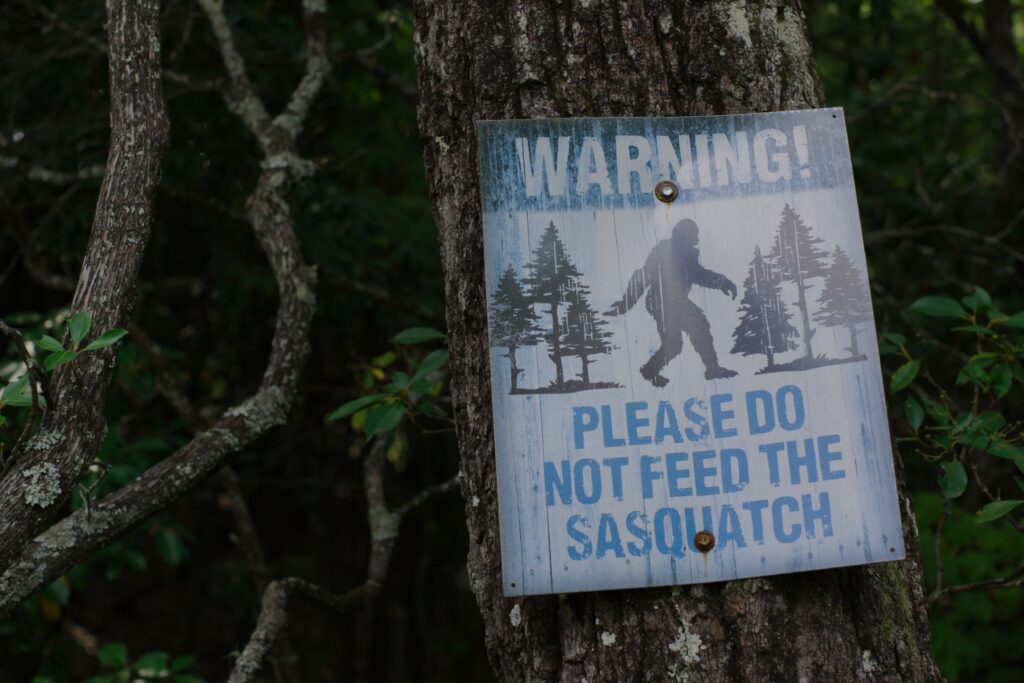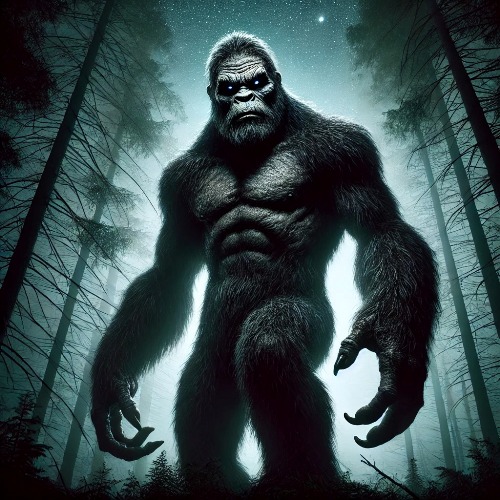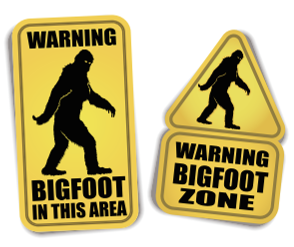
Think about the following questions.
1. Do you know any stories about mysterious creatures? Where were they seen?
2. Do you think that such creatures exist? Why or why not?
3. What have you heard about "Bigfoot"?
VOCABULARY PREVIEW
Match each New Academic Word List(NAWL) word with the correct definition.
- habitat
- fringe _____
- similarity _____
- emit _____
- specimen _____
- periodic _____
- a. an area of activity that is related to but not part of what is central or most widely accepted
- b. the place or type of place where a plant or animal lives
- c. happening regularly over a period of time
- d. to send out; to give off
- e. a way in which a person or thing is like another
- f. an individual animal or plant collected as an example
BIGFOOT

Native American and Canadian tribes have passed down stories for thousands of years about giant ape-men living in the forests of the western United States and Canada. They called these creatures Bigfoot, Sasquatch, or Mountain Devils. Regardless of the name, the descriptions of these animals are usually the same. Bigfoot is described as being very tall-well over two meters. It is covered in thick, dark hair and usually emits a bad odor. Its body is usually very muscular1 and ape-like, yet it walks upright2 and has a face more similar to that of humans than that of apes. For the most part, this creature appears not to be violent or aggressive. Bigfoot sightings are usually of lone, or single, creatures, but there have been periodic reports of people seeing groups or families of Bigfoot. People in other countries also tell stories of similar ape-men. In the Himalayas, a mountain range in Nepal, people call these creatures Yeti or Abominable Snowmen. Some Africans call them Nandi bears, and the Chinese tell stories of the Gin-Sung, or "Bearman."
Though sightings have been reported for centuries, is there any scientific evidence for the existence3 of these creatures? Some say yes, and others say no. Dr. Grover Krantz, a physical anthropologist4 at the University of Oregon who died in 2002, believed that Bigfoot may be a type of creature known as Gigantopithecus. The Gigantopithecus are a group of apes that lived in Asia—maybe as recently as 100,000 years ago—but are now believed to be extinct5. They had many physical similarities to the legendary6 Bigfoot. Dr. Krantz argued that these animals may have actually migrated from Asia and settled in the heavily wooded area of the US Pacific Northwest, where food was plentiful.
Is it possible that creatures like these could have survived for so many years, unknown to humans? Cryptozoologists are researchers that study mysterious creatures whose existence has not been proven. These researchers compare the case of Bigfoot to that of the coelacanth. The coelacanth is a type of fish that was believed to have become extinct over seventy million years ago but then was discovered to be still living off the coast of South Africa. Cryptozoologists suggest that the animals that we now call Bigfoot have been able to survive by living in habitats where people, until recently, have seldom gone.
There are, however, some questions that cryptozoologists have been unable to answer, which is why their ideas remain on the fringe of science. For example, why have no dead Bigfoot specimens ever been discovered? And where is the physical proof of their existence? Bigfoot researchers point out that it is unusual to find the dead remains7 of any animal in the forest. Most of the time, they say, other animals eat the remains soon after death; this may be the case for Bigfoot, too. Many skeptics8, however, say that the videos and photographs of Bigfoot are really pictures of people wearing ape costumes. They also believe that the Bigfoot footprints are really the footprints of a bear, or footprints made by tricksters trying to fool scientists.
It is possible that we may never know the truth about these creatures. If they have avoided being seen for thousands of years, then maybe they will stay hidden for another several thousand. Or it may be that as we humans go deeper and deeper into the forests of Northwest America and Canada, we may finally come face-to-face with the elusive9 Bigfoot.
New Academic Word List
- muscular1 : adj. having large, powerful muscles
- upright2 : adv. on two feet instead of four
- existence3 : n. the state of being real
- physical anthropologist4 : n. a scientist who studies the biology of human beings and related species
- extinct5 : adj. no longer existing
- legendary6 : adj. told about in stories that are believed by many but are not proven to be true
- remains7 : n. the dead body of a person or animal
- skeptic8 : n. a person who doubts or questions something
- elusive9 : adj. a person who doubts or questions something
READING COMPREHENSION
A ‣ Mark each statement as true (T) or false (F) according to the reading.
- Stories about Bigfoot first appeared a few centuries ago.
- True
- False
- One scientist thinks Bigfoot could be a type of ape that is believed to be extinct.
- True
- False
- The coelacanth is an extinct type of fish.
- True
- False
- No one has ever found any Bigfoot remains.
- True
- False
- Some people think that Bigfoot evidence was created as a trick.
- True
- False
B ‣ Choose the best answer according to the reading.
- What does the reading mainly discuss about Bigfoot?
- a. Why stories are told about it
- b. What different people believe about it
- c. What animals it most looks like
- d. Where it probably comes from
- What can be inferred about Dr. Grover Krantz?
- a. He was well known as a Bigfoot skeptic.
- b. He spent most of his career researching mysterious creatures.
- c. He thought people were telling the truth about seeing Bigfoot.
- d. He was the first to discover Gigantopithecus.
- Why do cryptozoologists think that the coelacanth provides support for the existence of Bigfoot?
- a. Because its existence has also not been proven by science
- b. Because it looks like a close relative of Bigfoot
- c. Because it is also a strange-looking animal that was described in legends
- d. Because it shows ancient species can still exist without being easily found
- The word They in paragraph 5 refers to _____.
- a. skeptics
- b. videos and photographs
- c. ape costumes
- d. people
C ‣ The following terms are explained in the reading. Write definitions for them.
- Gigantopithecus
_____ - cryptozoologist
_____ - coelacanth
_____
SUMMARY
Fill in the blanks with the phrases in the box.
- photos and footprints
- muscular and hairy
- in many cultures
- know for sure
- be Gigantopithecus
- no specimens
|
Does Bigfoot exist? |
||
|
Description
|
Supporters
|
Skeptics
|
| We may never 6 _____ | ||
VOCABULARY PRACTICE
Fill in the blanks with the words in the box. Change the form if necessary.
- specimen
- habitat
- similarity
- periodic
- emit
- fringe
- Traditional light bulbs waste energy because they _____ heat as well as light.
- I always stay with my Canadian relatives during my _____ visits to Toronto.
- Many types of animals have become extinct because of the loss of their _____ .
- During his five years traveling on the Beagle, Charles Darwin collected many interesting _____ of insects and other animals.
- One _____ between soccer and hockey is that in both sports, a single player guards the goal.
- The possibility of life on other planets is not a(n) _____ . idea; it is one that scientists take seriously.
SUPPLEMENTAL READING
The Death of Bigfoot?

Is Bigfoot dead? The answer is yes, according to the family of Ray L. Wallace, who died November 26, 2002, in Seattle, Washington. After the death of his father, Michael Wallace told a story that surprised many people who had been trying to solve the Bigfoot mystery. He claimed that his father had made up the idea of a Bigfoot creature; though he did not invent the name “Bigfoot,” he developed it as a practical joke to make money. According to Michael, Ray Wallace asked a friend to make a pair of sixteen-inch (40 cm) feet out of wood. Wallace then used them to make fake Bigfoot footprints around the woods near his house. Wallace would use these footprints to support the stories about Bigfoot that he told to newspapers. Some of these stories were quite strange.
He once told a newspaper reporter, "[Bigfoot] creatures are people; they speak a language." Wallace tried to make money from these stories. He made tape recordings of strange sounds that he said were “Bigfoot conversations" and sold the tapes to tourists along with Bigfoot photos, posters, and pieces of animal hair that he said came from Bigfoot.
Though his family claims that Bigfoot died with Ray Wallace, others are not so sure. Scientist Jeff Meldrum, a professor at Idaho State University, does not believe that Bigfoot is imaginary. Professor Meldrum claims to have copies of over forty footprints that he says belong to a very large, unknown creature, which he believes is the real Bigfoot.
Fill in the blanks with information from the reading.
- According to Michael Wallace, his father made up the idea of a Bigfoot creature in order to _____.
- Ray L. Wallace also sold tapes of what he said were _____.
- One person who disagrees with Michael Wallace is Professor _____.

Leave a comment
Load more